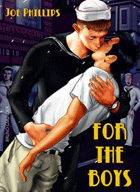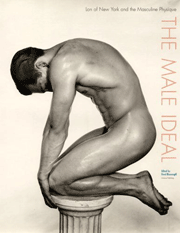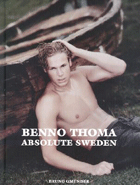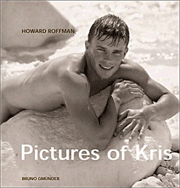Eye Candy is Great! No Calories!
 For
the Boys
For
the Boysby Joe Phillips
Berlin, Germany: Bruno Gmunder Verlag Gmbh, 2004
ISBN: 3861873834
The cartoon art of Joe Phillips is simultaneously both funny and sexy.
His sense of humor, especially his parodies of classic Norman Rockwell All-American holiday moments transposed to male gay sex scenes are wickedly funny. Even his cover is a superb parody. Any person over the age of fifteen has seen reproductions of Life Magazine photographer Alfred Eisenstaedt’s 1945 “V-J Day in Times Square.” It is one of the world’s most famous photographs. A sex-starved sailor is kissing a nurse in the middle of New York City’s Time Square to celebrate the end of World War II with the news of the Japanese surrender. The powerfully built Navy man in uniform has grabbed the first gorgeous woman he sees and nearly bends her in half while planting a huge and presumably very lengthy kiss on her lips. The surrounding busy crowd smiles in gleeful approval of the celebration. Phillips turns Eisenstaedt’s “V-J Day in Times Square” landmark photo upside down. In Phillips’ cartoon “Kodak Moment” bystanders stare in wonder as the same hunky sailor grabs the first good-looking MAN he sees and proceeds with the famed, immortal kiss. It is a wonderful moment in gay visual art history, and all rendered in Phillips’ hallmark neon colors.
Open the book to the title page and Phillips’ sexy and wonderfully fun sense of humor continues. There is no typical title page solemnity here. The scene is Waikiki Beach and hunky surfer’s drawers (with the name Joe Phillips, not Ralph Lauren, emblazoned on the elastic band) and swim suit are worn slung extra-low revealing a good piece of the stud’s buns niftily tattooed with the book’s title, “For the Boys.”
For the Boys employs an innocent sweetness as well as pure eroticism. In one painting, a clearly surprised deep sea fisherman brings ashore his latest catch. The prize has a tail, but is clearly not Andersen’s “The Little Mermaid.” In this case, it is more likely a “Sir”-maid and the catch clearly has no objection to having been reeled in and held in a pair of brawny arms.
There are also a sexy Moscow ice king, two sexy Santas, an Egyptian Pharaoh being made love to by his Nubian slave, two of the most masculine bear lovers ever painted. (Eat your heart out, Smokey Bear!) The forest ranger and Wildlife Resources doc clearly love the little black bears they have rescued, but there is little doubt as to the bare fun these bear lovers will have when it is nap time for the cubs. Another sweet painting hints at a first date. A wide-eyed young stud, clearly pleased with the stranger who has found his way to his front door remains unaware that his handsome visitor holds a heart-shaped gift box of candy behind his muscular back. Who else but Phillips would put Tom Sawyer and Huck Finn as two muscular, robust, and well-made partners clearly in love on his front piece work of art?
One of Phillips’ very best scenes reveals a hyper-masculine beach “boy” licking the fingers of one hand while holding in his other hand—at crotch level—the largest Coney Island hotdog ever made. No one will miss the artist’s over-the-top symbolism.
Part of the joy of the eye candy in For the Boys is the extra special gay pride his men exhibit. Two extraordinarily handsome and physically well-developed football players kiss passionately right on the gridiron, obviously unconcerned about what others may think. In yet another great scene, two straight guys in a moving van stare dumbfounded as traffic is held up while a “Superman” motorcycle cop issues not a citation to a bare-chested surfer in his convertible, but smacks the speed violator with a huge, wet kiss.
Phillips’ art work is highly suggestive and he teases far more often than he reveals explicit showings of male genitalia, but when he does put the complete package on display, readers can be sure the male cartoon model is size XXX LARGE!
Phillips’ strongest virtues as an eye-candy producer are his vivid palette and his sense of playfulness. (Phillips’ strong emphasis on multiculturalism is a nice touch, too, in For the Boys.) No where else in gay art is color so vibrant. Somewhere, a long time ago, someone’s gaydar must have been turned on and they surely gave Joe Phillips, the boy, the brightest package of crayons ever created. He may use different media today, but, oh, boy, the COLOR is still there. Second, Phillip’s sense of humor, especially with artistic and cultural parody is unsurpassed in gay art.
 The
Male Ideal: Lon of New York and the Masculine Physique
The
Male Ideal: Lon of New York and the Masculine Physiqueby Reed Massengill
New York: Universe Publishing, 2004.
ISBN: 0789309963
There is some reluctance to place Massengill’s The Male Ideal in the “eye candy” category, because Alonzo James Hanagan, its subject, who came to be known as Lon of New York was unquestionably the pioneer physical culture or physique photographer in the USA, and one of the greatest photographers of the male nude in the whole of the past century. He was also a remarkably courageous man who saw most of his beautiful photographs destroyed in police raids at a time when images of male nudes were not just culturally unacceptable but illegal. The police took particular joy in destroying not only the prints of Lon of New York, but also the negatives of his great art photography of male nudes. The New York City, Detroit, and other police forces were not all that far removed from using Gestapo tactics when it came to their brutal conduct against gay photographers in the first half of the 20th century.
The Male Ideal photographic monograph does fit with other “eye candy” books, however, because of its abundant photographs of gay males displaying more full frontal nudity than any other book in this review of masculine art.
But GLBTQ populations should be sure to read Massengill’s commentary along with enjoying Lon of New York’s masterful black-and-white and sepia images. Those who rightfully fear the current homophobic climate in the nation today most likely have no idea of just how discouraging and depressing life must have been for photographers of the male nude form in the decades of the 1930s-1950s. Massengill describes one such brutal invasion of the private home of Lon of New York. Referring to his second arrest and raid on his home and studio, Lon told Massengill:
The postal inspectors
arrested me, and shortly after [making bail and returning home], the
local police came and went through everything. They threw negatives on
the floor and trampled them, destroying printings, including a lot of
family photographs, and took us (model Frankie Giardina was with Lon)
both to jail. They said, “You degenerate! You queer! People like
you should be annihilated!” (p. 34)
That from “New York’s Finest!”
Alonzo James Hanagan was gifted in many areas, including music. As early as his teens, he spent long hours in movie houses playing theater organs and later was the church organist at St. Paul’s Lutheran Church in Brooklyn. He was also a talented pianist and entertained at Big Apple parties with his wit and incomparable repertoire of popular music.
Hanagan made his way into gay art photography through the physical culture movement and the exceptionally popular growth of magazines such as Strength and Health, Your Physique, Muscle Power, Tomorrow’s Man, Star Models, and Men and Art, some of which Lon published himself. In his time, from the 1930s through the 1950s and into the 1960s, Hanagan was known as a physique photographer. In addition to earning a living through the sale of photographs to physical culture and body builder magazines and publishing his own, he also opened the studio Lon of New York—Artistic Physique Photography at 19 West 46th Street, near Fifth Avenue from which he sold photographs.
As brave and laudable as Hanagan was, and as fascinating as his heroic historical story is, Massengill has truly put together an eye candy masterpiece that shows the splendid evolution of photography of the male nude form decade by decade.
The 1930s are represented by dramatically posed men whose musculature clearly is intended to represent the Greek ideal, including the full and open showing of male genitalia. The models photographed are all white and have the same “staged” appearance of movie star portraits of the same era.
The 1940s era photos open up to plein-air photographs of models in slightly less posed images, especially seen leaning against rocks or standing in open fields. Rightfully, Lon of New York also introduced African-American males in the 1940s era, once again emphasizing the beauty of the male human form, regardless of race. Perhaps because it was a time of great war, the 1940s photographs often show men with swords, javelins, and taking more warrior-like positions.
The 1950s represented a productive era for Lon of New York who exhibited somewhat of a return to the highly posed photograph, but also placed an ever greater physical culture emphasis in his magnificent images of manhood. Muscles were on parade. For eye candy lovers, Lon’s 1950s images were neither shy of presenting models in full frontal nude poses or in portraying models who are black, white, and even Asian. The glory of male nudes fully showing off their complete manhood for viewers’ pleasure continued in the exquisite reproductions of a master photographer in the 1960s cultural era that featured a definite return to the 1930s Greek heroic imagery.
The Male Ideal is a splendid time capsule of masculine nude photography in the middle decades of the 20th century. Lon of New York was certainly one of the great photographic artists of the male form and his “eye candy” is a bonus that comes with Massengill’s fascinating and engrossing history of the period. There are no blemishes in a Lon photography. His models and his images clearly are THE MALE IDEAL.
 Absolute
Sweden
Absolute
Swedenby Benno Thoma
Berlin: Bruno Gmunder Verlag Gmbh, 2002
ISBN: 3861872161
On this writer’s first trip to Europe, he became convinced that the handsomest men and most beautiful women in the world were Swedish, or at least Scandinavian. Nothing in Benno Thoma’s Absolute Sweden changes that three decades-old impression, at least as far as young males are concerned. Absolute Sweden is clearly the Godiva Chocolates version for readers of the eye candy library. Thoma’s models are not only strikingly manly and handsome, they have an equally unabashed innocence and comfort with their naked forms. They seem to coax readers -- “Come on, join in our work, our pleasures, and outdoor adventures.” And, oh, boy, does the reader ever want to accept the offer.
Three features are striking in Thoma’s Absolute Sweden. First, these models are not only fresh, they are hard and masculine and completely at home in all the elements. Some of the sexiest images ever photographed must be Thoma’s young Swedish models working and playing throughout the seasons, including nude engagement in recreation and comradeship in the ice and snow of the great Northland. Toma’s plein-air photography is marvelous. Swedes clearly love the great outdoors during any season. It can be no surprise that the 1912 Olympic Games held in Stockholm, Sweden, were forever after referred to as the “Sunshine Olympics.” As Peter Kuhnst writes in Physique (Thames & Hudson, 2005), “The Art Nouveau movement, with its life-reforming motifs and figures of well-conditioned bodies was evident during those Olympic Games.” (p. 39)
Second, many of Benno Thoma’s models are just on the cusp of manhood. They are not boys any longer, but they are clearly enjoying the first brushes with both the work and pleasures of manhood. They are incredible examples of a very natural masculinity.
Finally, the comfort level of the models with their nude and semi-nude bodies may well be unparalleled in photography of males from any other land. In Absolute Sweden, the models appear not only to enjoy the great outdoors, but to be totally unaware that they are being photographed. Occasionally, youthful Swedes appear contemplative, but they never appear self-conscious or studied. Thoma’s photographs are remarkable in their freshness. The models appear completely natural and casual. They frolic in the surf at one turn, and chop wood for the outdoor sauna which they soon use with gusto. Their superbly masculine bodies appear perfectly matched for all seasons and for the incredible splendor of their homeland.
Roffman spent three years photographing his subject solo as well as enjoying passionate sex as one third of an alluring gay ménage a trois. Roffman’s splendid book is really photographic memoirs of a young man who shows a hesitancy and slight discomfort with his gorgeous and well-endowed body at first glance, but through the pages and through his encounters with two slightly older young men gains a confidence that is, with the pun most definitely intended, “cocky” and far more self-assured, but never less than gracious in his willingness to share his incredible life and his incomparable masculine good looks with others.
The variance of photographs is remarkable. The threesome sex scenes are among the most erotically-charged photographs this reviewer has ever seen in a gay photographic books, yet in these same pages, Kris frolics innocently with a puppy who seems no less innocent than his human friend, casually reads the morning newspaper, explores the world with his laptop computer, or merely relaxes in a wicker chair.
In the three years Hoffman photographed Kris solo and with his male comrades they toured much of the globe. The photographs were taken in England, Amsterdam, Paris, Barcelona, South Africa, and Australia. But it is not the geography of the world that counts in this splendid book of eye candy. It is the geography of Kris that counts. He is an incredibly handsome young man, superbly endowed, who starts his trip through the pages of Hoffman’s visual memoir as an innocent abroad, but who ultimately ends up fully confident with the images of the man that he has become. He is completely at home with his masculinity and his incredible sexuality.
—Jerry Flack, Colorado
